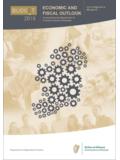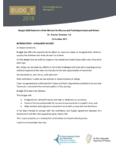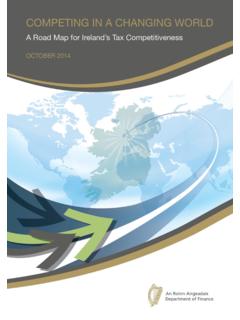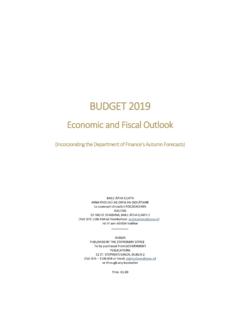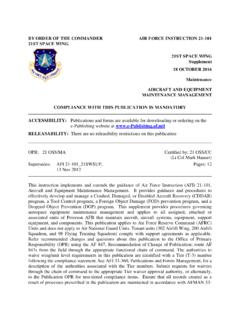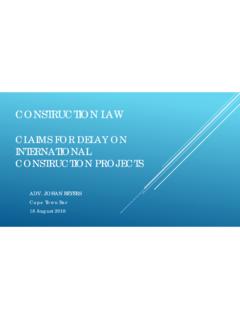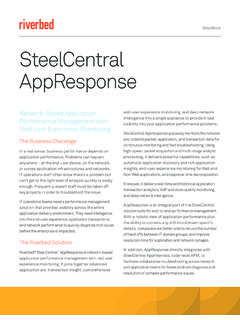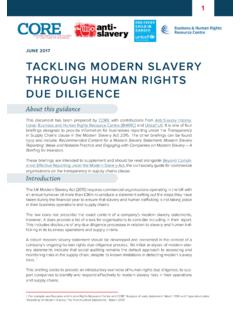Transcription of EXCHEQUER CAPITAL ENVELOPES 2018-2021: …
1 EXCHEQUER CAPITAL ENVELOPES 2018 -2021: OUTCOMES OF MID-TERM REVIEW OF THE CAPITAL PLAN New Projects and Programmes Central CAPITAL Policy Section 1 Summary CAPITAL expenditure will increase by approximately 85% between 2016 and 2021. Gross voted CAPITAL expenditure will reach of GNI* by 2021 and will account for over 11% of total voted expenditure. This will see public investment in Ireland moving from relatively low levels to among the highest in the EU. In line with the assessment of the Mid-Term Review of the CAPITAL Plan the following priorities have been identified for public CAPITAL investment:- o Transport public transport and the maintenance and upgrading of the road network; o Housing - on the basis of the review of the Action Plan for Housing and Homelessness; o Education higher education and the schools building programme; o Health drawing on further analysis of the totality of health capacity and infrastructure; o Business, Enterprise and Innovation in order to address the potential impacts of Brexit; and o Communications to ensure the delivery of Ireland s National Broadband Plan and assist in meeting Ireland s climate and energy targets.
2 Alongside these priorities substantial additional public CAPITAL investment is also planned in other key sectors. The multi-annual additional allocations for each Vote/Vote Group are set out in the table following: million 2018 2019 2020 2021 Total 2017 vs. 2021 in Ceilings Additional CAPITAL 206 1,030 1,411 1,652 4,300 Transport, Tourism & Sport 45 315 413 485 1,258 124% Housing, Planning & Local Government 28 157 231 283 700 102% Education & Skills 28 191 190 254 663 45% Health 20 117 154 180 471 72% Business, Enterprise & Innovation 40 70 100 100 310 8% Communications, Climate Action & Environment 8 0 86 106 200 85% Justice & Equality 5 69 48 35 157 22% Agriculture, Food & the Marine 10 17 50 57 134 11% Office of Public Works 5 22 30 35 92 71% Defence 3 21 35 39 98 62% Culture.
3 Heritage & the Gaeltacht 4 24 29 33 90 56% Rural & Community Development* 11 8 11 13 43 n/a Foreign Affairs & Trade 13 17 13 13 30 18% Children & Youth Affairs 1 5 7 8 21 25% 2 Employment Affairs & Social Protection 1 5 7 8 21 60% Public Expenditure & Reform (less OPW) -5 3 10 4 12 -72% Finance 1 0 0 0 1 -29% Note: Rounding effects *This Department was only established in July 2017. The CAPITAL Plan 2016-2021 The CAPITAL plan, Building on Recovery: Infrastructure and CAPITAL Investment 2016-2021, was published in September 2015 and sets out the Government s budgetary framework for public CAPITAL investment in Ireland over the period 2016-2021. The details of over 100 major infrastructure projects and programmes included in the CAPITAL plan are set out in the Major CAPITAL Projects Tracker.
4 This tracker was recently published for the first time on the Department of Public Expenditure and Reform s website on 14th September 2017 (link). The tracker highlights the scale of delivery of major projects across all sectors of state activity. Following the allocation of additional CAPITAL expenditure in Estimates 2018 the tracker will be updated to reflect the latest allocations and the additional CAPITAL investments which will be delivered. The tracker will provide the public with reliable and timely information about the delivery of current and future infrastructure. Subsequently it is intended to publish an updated tracker twice yearly. In the relatively short period since the CAPITAL Plan was published the context for public CAPITAL investment has changed dramatically.
5 The significant progress made in restoring the public finances and the transformation in economic performance has enabled Government to supplement the 27 billion committed to public investment between 2016 and 2021 by over 8 billion. This will result in CAPITAL expenditure increasing by approximately 85% between 2016 and 2021. Gross voted CAPITAL expenditure will reach of GNI* by 2021 and will account for over 11% of total voted expenditure. As recently confirmed by the Irish Fiscal Advisory Council s Pre-Budget 2018 Statement, this will see public investment in Ireland moving from relatively low levels to among the highest in the EU. Taking account of the significant additional resources of billion which has been provided to support the delivery of the Action Plan for Housing over the period, billion in additional CAPITAL expenditure has been allocated in Estimates 2018 for the remainder of the period out to 2021 as set out in the table following.
6 The total allocation of increased resources for public CAPITAL investment over and above what was included in the CAPITAL plan is billion, an increase of over 30%. 3 Table 2: Reconciliation of CAPITAL Plan with Updated CAPITAL Ceilings in Estimates 2018 billion* 2016 2017 2018 2019 2020 2021 2016-21 CAPITAL Plan Ceilings SES 2016 Additional CAPITAL 0 2016 Technical Adjustments** SES 2017 Additional CAPITAL 0 0 0 Estimates 2018 CAPITAL Ceilings CAPITAL Ceilings as % of GNI* * Rounding effects. ** Includes the reclassification of PPP unitary payments from current to CAPITAL , CAPITAL carryover and Budget 2017. outcome of the Mid-Term Review The Mid-Term Review of the CAPITAL Plan, published on 14th September 2017 (link), draws on an evidence base that included submissions by Departments and Offices, an extensive public consultation (link), and also an Infrastructure Capacity and Demand Analysis (link) completed by the Irish Government Economic and Evaluation Service (IGEES) in the Department of Public Expenditure and Reform.
7 The review of the CAPITAL Plan highlights some key themes which will closely inform and be incorporated into the analysis leading to the finalisation of the new ten-year National Investment Plan. These themes include:- confirmation of the central role of public CAPITAL investment in underpinning the economy's long-term growth potential and addressing overheating risks as well as supporting social progress; the need to align public CAPITAL investment priorities to a changing demographic profile; the critical importance of public CAPITAL infrastructure in meeting the essential requirement for balanced regional growth and promoting the societal transformation required to achieve climate action objectives; the mechanisms through which public investment can strengthen the economy s resilience to major risks such as Brexit.
8 The central importance of robust mechanisms to support the efficiency and value for money of public CAPITAL investment; and the strong business case for ensuring that public CAPITAL spending is balanced between new projects and maintaining the quality and capacity of existing public CAPITAL infrastructure. 4 Based on the analysis, the review of the CAPITAL Plan has identified a number of key sectors as priorities for investment, including transport, education and housing. The findings of the review assisted Government in selecting priorities for the allocation of additional funding now available over the period to 2021. Other sectors, not accounting for a significant share of overall public CAPITAL investment such as Justice, Defence, Sports, and Arts were not subject to the infrastructure capacity and demand analysis.
9 Demographic projections are such that these sectors are likely to be subject to demand pressures over the remaining years of the CAPITAL Plan. It is clear from the submissions received that public infrastructure in these areas also requires increased investment to achieve a balanced prioritisation of increased public CAPITAL investment across all sectors of government activity. This new planned level of CAPITAL investment represents an appropriate balance between the need for additional investment, the sustainable capacity of the economy to deliver additional public infrastructure and the need to adhere to the responsible spending path agreed by Government with reference to the requirements of the EU Fiscal Rules. The review of the CAPITAL Plan will also provide a significant input into the development of the proposed new long-term 10 year National Investment Plan, to be published in conjunction with the Minister for Housing, Planning and Local Government s new National Planning Framework (NPF) - the objectives of which are fundamental to the achievement of long-term economic, social and environmental sustainability.
10 While the allocations made in Estimates 2018 have been informed by the evidence and analysis produced in the CAPITAL review, the significant constraints and demands highlight the need to place an increased emphasis on project selection, appraisal and evaluation. In addressing any identified infrastructure needs a concerted focus is required on getting project selection right in order to ensure that the underlying problem is addressed and that value for money is achieved. As such, it is vital that all projects are selected on transparent criteria and well-established methodologies as outlined in the Public Spending Code. Each Government Department must ensure that individual projects and investment proposals are subject to all of the relevant appraisal processes and value for money tests before EXCHEQUER resources are finally committed.

